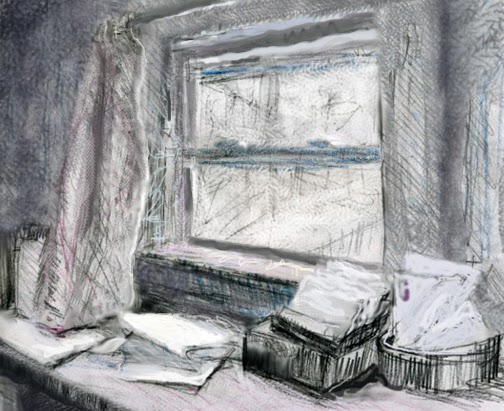 |
| Road to the Pond (digitally edited oil sketch by Jude Spacks, 2014) |
A friend felt she'd made a big mistake. Even though it had come out alright in the end, she obviously had to buckle down to some hard-labor inner work now. Where had she gone wrong? The story echoed resoundingly with unhappy themes from way back when. What ghastly hidden motives, tendencies and confusions needed to be untangled and cleared up? (In a most compassionate and forgiving way, of course). There must be something important to learn from all this. She'd called to ask for my help to go digging for it.
So many times I've diligently set about 'dealing' with an inner world snafu like this, believing I couldn't get over it until I'd bravely dived into the depths, mining for insights. But lately I've been semi-retired from busying my brain this way, even though I was pretty good at the job--a useful one at times, no doubt.
I saw a little cartoon in my imagination: I'm homeless, rattling a cup for spare change, with a cardboard sign saying, "Will delve for food."
A theory popped out of my mouth. "Fresh new
neuropathways are being built, ones leading to creative, healthy ways to respond to experiences like this. So it's best not to send a whole lot of thought-traffic through right now. Let the mind slow down, give the new ways some space to develop. If you spin out a high volume of serious thoughts, they'll have to take that big old superhighway which you really don't like traveling on anymore."
Traffic
"Did you just make that up?" she asked.
"Yup," I said, "I guess so. What if there's really nothing to figure out? The voice of wisdom is
notoriously still and small. Easier to hear when it's quieter inside. Amble on down a country road, without any hurry to get there. This whole experience has gone into the past now. Why not just let it be over? Play hookey from the school of Learning What's Wrong With You That Caused 'Mistakes'."
"I can't tell you how relieved I feel hearing that," she sighed.
My cat stretched in her sleep and tucked her nose under her paw. Pretty soon, my friend got off the phone to go spend time with her son.
----------
"Don’t give rise to any thought, and discover who you are."
--Papaji
------------------------------------------------
Would you like to explore how you can more fully
discover
freedom from stressful mental habits
and live with the clarity and ease of your natural wisdom?
Truth and Dare Coaching invites the liberating laughter
of seeing through scary self-made illusions
to the reality of your own brilliance in action.
Fill out this questionaire, and we can have a (no charge) conversation
to explore whether we might be a good fit to work together











